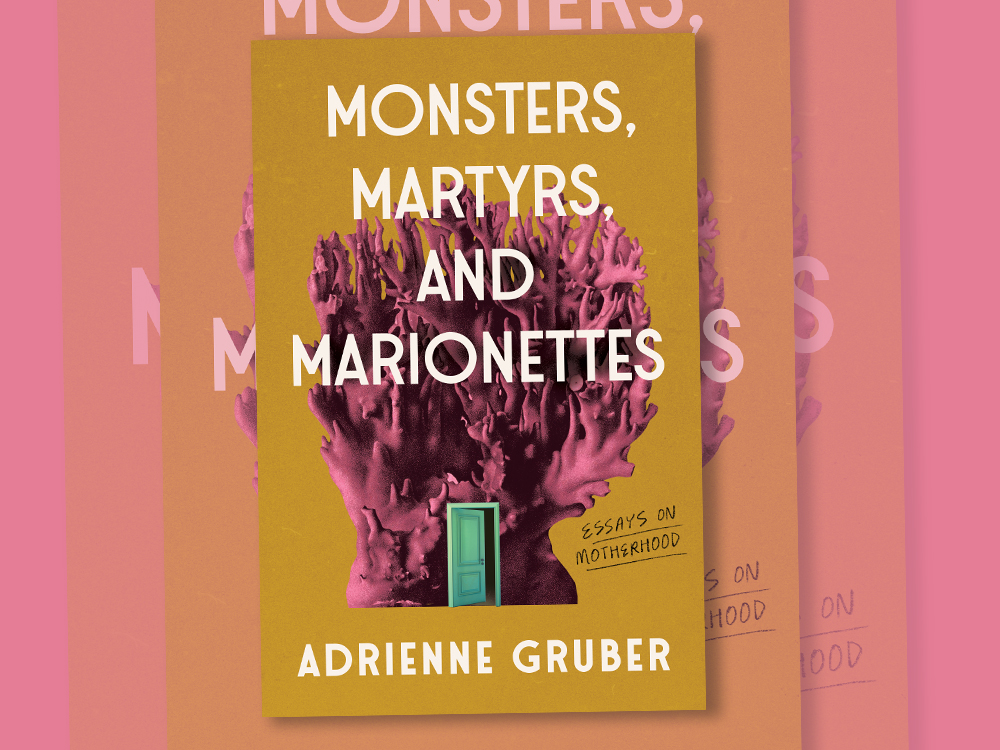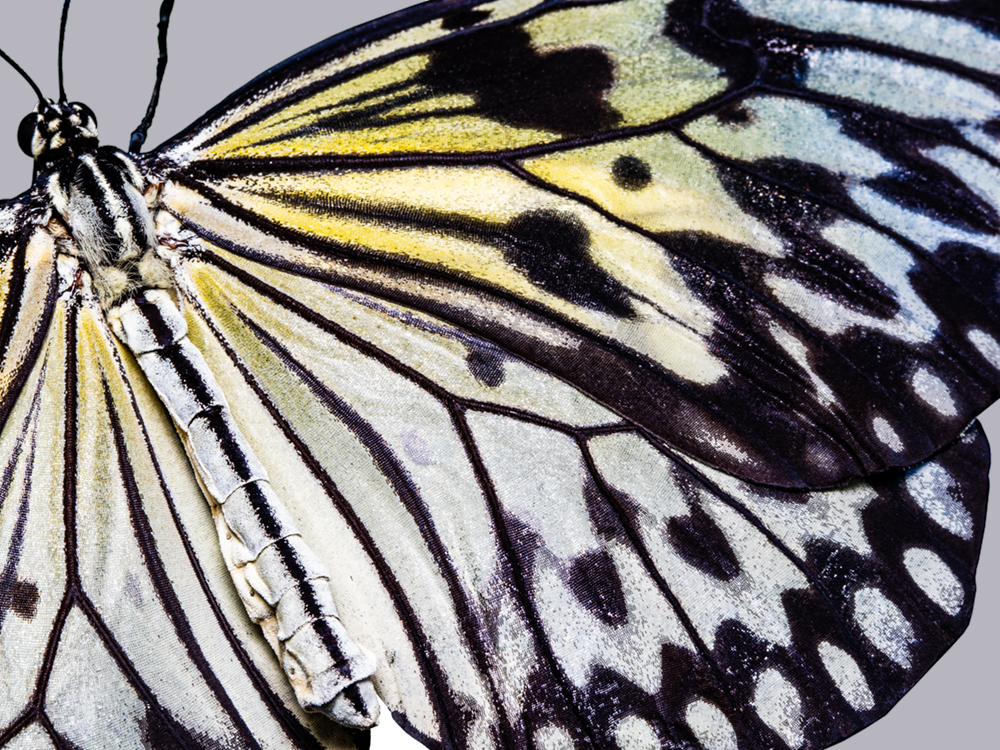[Editor’s note: Adrienne Gruber’s new book, ‘Monsters, Martyrs and Marionettes,’ out now from Book*hug Press, is an unflinching and deeply personal examination of motherhood — and it will be a balm to those whose families, despite their best efforts, are mired in both the banal difficulties of everyday life and the bigger, more serious difficulties, the ones that threaten to swallow us whole. ‘Can a Dead Mother Be Sad,’ published in the book as ‘Fractal,’ encapsulates the way Gruber uses a poetic sensibility to climb inside the parts of parenthood that can be so hard to share with others.]

At the fractal exhibit at Science World there are glass boxes separating butterflies, fossils and leaves. Five-year-old Quintana and I examine the complexity of the butterfly wings, noting the unique dimensions as the veins subdivide. The wing pattern is a complex lattice of processes, timing and genetics, and each element blends together — pigmentation, pattern size and shape, position — after the caterpillar enters its pupal stage.
Quintana holds a magnifying glass up to her eye, but doesn’t know to bend down. She’s instantly enraged that the butterfly wing seems so far away. Her hair falls in blond wisps around her small, fuming face.
Mesmerized by the never-ending patterns, we twist knobs and dials on a display case. Branches grow from the trees and twigs grow from the branches. This keeps going until we reverse the knobs and dials and the growth disintegrates.
She comes home from kindergarten and points out fractals in the laminate flooring and her stripey socks. In the succulents on the windowsill. In her sister’s tangled hair.
Daily, Quintana thrashes her limbs at me and I can’t retract my own violence. My fists clench. My voice is sharp. I sit on my hands to keep from smacking her. She beats her wings and there’s a 6.4 earthquake in California.
She says, “I’ll laugh when you’re dead. I’ll cut you. I’ll push you off the balcony. You’ll be sad when I kill you.”
Can a dead mother be sad?
Dennis, fresh from the shower, sits on the floor in his underwear and holds her while she thrashes against his large, damp body. It’s 8:55 a.m. We’re in a state of disorder. We’re late for school again.
Chaos explores the transitions that exist between order and disorder, which often occur in surprising ways. Anger erupts from my daughter with ease. She spews it, volcanically, in every direction.
Dennis and I sit in the windowless office of our daughter’s psychologist, Janine. Neither of us says it, but we both fear the session isn’t worth the $200 we shelled out, that we’ll leave with nothing to show for it. After answering dozens of questions about the interactions between us and our daughter, between our daughter and her friends, her sister and her extended family, after revealing our lack of parenting strategies and complaining bitterly that our home life is just fucking hard and basically poor us, Janine agrees that we could use some help.
“Most of us live at about here,” she says, raising a hand and holding it flat in front of her chest, “and it sounds like Quintana lives right about here,” she raises her other hand several inches above the first, until it’s hovering in the air at eye level. “Her anxiety level means she’s experiencing things at a higher frequency. A flurry of activity and noises can overwhelm her.”
Kindergarten begins in September. Kindergarten ends in June. Grade 1 begins in September. Transitions are fractals.
My mom has five sisters. When they’re together, their personalities magnify, become larger than life. They cackle and sing and dance. They cry intricate tributaries of their mother. Each one has been incapacitated by panic. Each one has been swallowed by denial. I hear about these lapses through my mom’s fragmented telling. Through the secret emails of cousins, their daughters. Through confessional Christmas letters from aunts.
I use my own therapy as an excuse to abandon my daughter. I schedule appointments during her peak rage times and make sure the clinic is an hour away by bike. I cycle to save the environment, I tell myself. Afterward, I stay late at the Lonsdale Quay, order maki rolls and dip them into wasabi paste — the fever in my mouth, a purification.
Some days Quintana launches herself naked at me. Her movements are quick and agile. Spastic. She’s out for the kill.
Fractals are most commonly found in nature: Trees, rivers, coastlines, mountains, dumb mom, clouds, seashells, fiddleheads, geckos’ feet, lightning bolts, Romanesco broccoli, you’re just a dumb mom, Queen Anne’s lace, peacocks, snowflakes, pineapples, systems of blood vessels, you’re dumb and stupid, crystals, sea urchins, stalagmites, stalactites, hurricanes, you stupid dumb mom. Daughters.
We tell Janine about Quintana’s tics: the eye-blinking, the coughing between each word, the licking her lower lip until it scabs. How, when we speak at the same time, she covers her ears with her hands and screams, unable to absorb anything we say, though we’ve had her hearing checked twice and both times she tested perfectly. How we had to buy $75 Hunter rain boots because they have a special flexible rubber that allows her to curl her toes like snails.
“You bring that up a lot,” Dennis says to me after the session.
“Well, it’s a fuck-ton of money to spend on kids’ rain boots,” I say. At night Quintana begs to sleep with me. In the king-size bed, she folds her limbs around mine and clings to me in the dark. Her tiny feet imprint crystals between my calves. We exist as information for a new study.
The brain is organized fractally. It branches inward, thousands of pyramidal neurons clustered in its forest, like a cosmic tree. Dendrites stretching and connecting. Synapses transmitting and receiving. Branch in, branch out. Loop back.
Just like that, a switch is flicked and she is perfect, or as close to perfect as we could order. Goofy. A lopsided bottom-toothless grin. She flops her head around with a brand-new haircut, a bob requested after two years of a dedicated Rapunzel length. Her eyes are velvet, her touch soft, and I don’t dare make any false moves.
We practise breathing at home and even that is a fractal. I search abstracts with titles like “Possible Fractal and/or Chaotic Breathing Patterns in Resting Humans,” questioning if patterns of breathing are consistent with the properties of fractal or chaotic systems. I come across the fractal model of human bronchi, play a YouTube video and watch the branching blood vessels and arteries feather out and pulse.
I tell Quintana to fill her tummy with air until it looks like a balloon, and then to slowly let the air out of the balloon. It’s a game we can do together. She breathes in and out, slowly at first, her rhythm matching mine, then faster and faster until her eyes dilate and she’s panting and sweating. Then she hits me, a swift blow to my arm. She’d rather stay in chaos. Her anger and anxiety split from each other like two neighbouring water molecules that end up in different parts of the ocean. But even with great distance, fluids cannot be unmixed.
The veins in her arms subdivide and her wings are a formation of iridescent scales — her grandmother, her great-aunts, her mother, all nesting together, take flight. She dances around the glass display cases, flapping her arms.
Adapted from ‘Monsters, Martyrs and Marionettes: Essays on Motherhood.’ Copyright 2024 by Adrienne Gruber. Reprinted by permission of Book*hug Press. ![]()

















Tyee Commenting Guidelines
Comments that violate guidelines risk being deleted, and violations may result in a temporary or permanent user ban. Maintain the spirit of good conversation to stay in the discussion and be patient with moderators. Comments are reviewed regularly but not in real time.
Do:
Do not: